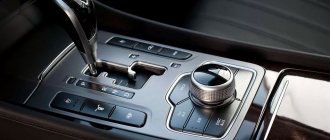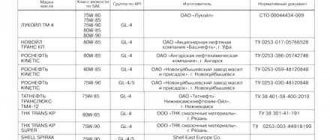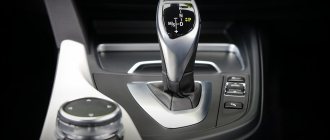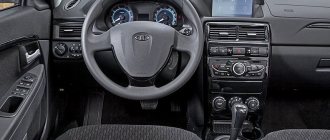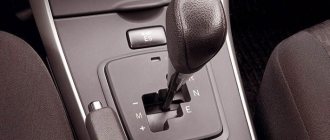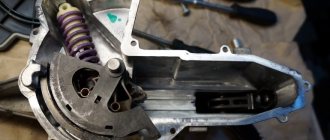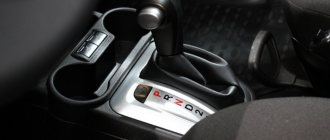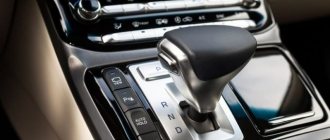The manual transmission is gradually fading into the background and we cannot exclude the possibility that it will be completely replaced by automatic analogues. At the same time, the number of modifications only increases each time. CVTs and other mechanisms appeared. And any car enthusiast simply cannot help but be interested in the difference between an automatic and a robot gearbox. To understand what is what, you should analyze the key design features, and then draw the appropriate conclusions.
It is worth noting that analogues appeared not so long ago and are still a new development, and therefore many car enthusiasts do not yet trust such a solution. Perhaps, if the mechanisms turn out to be more reliable than their competitors, then they will also receive recognition from owners of various vehicles.
Design of a conventional automatic transmission
This option is considered more reliable than other mechanisms, since it has already stood the test of time. The last argument on how to distinguish a robot from an automatic machine is significant, given that the mechanism appeared relatively recently. And if with a manual transmission the driver needs to periodically depress the clutch pedal and then turn on the desired speed (and this takes time), then the automatic transmission does all this itself.
These cars don't even have a clutch pedal. Not only passenger vehicles, but also trucks and buses are equipped with this mechanism. The first thing we will begin to study is how a robot differs from an automatic machine, this is the device of the latter. The transmission design consists of two blocks:
- Gearbox - ensures the transmission of forces through a chain of gears. The number of steps varies from 4 to 6, and in modern models it can reach up to 9. It is planned to make models where their number will be increased to 10 or more.
- A torque converter is an analogue of a clutch assembly, as is the case with a manual transmission. Thanks to him, it is possible to avoid shocks and jerks. The entire complex receives different information from many sensors - the number of crankshaft revolutions, driving mode and load. And based on this information, it switches speeds.
The stages are changed when a certain speed is reached, and pressure is created in the oil line. The driver's participation is not required.
Automatic dual clutch transmission
The Volkswagen concern undertook to improve the smoothness of “robots” by introducing a preselective “robot” with two clutches (DSG) on its models in the mid-2000s. In such transmissions, even and odd gears are located on separate shafts equipped with individual clutches.
The new type of gearbox, although it became quite expensive to produce, got rid of the slowness of the first “robots” and was even able to provide the car with better acceleration dynamics than versions with conventional “mechanics”. Subsequently, many leading automakers also began to switch to such automatic transmissions, ordering them from leading transmission manufacturers.
Advantages and disadvantages
This type of transmission would not have become widespread without certain qualities:
- Simple and convenient controls.
- Fuel consumption is economical.
- There is no risk of overheating due to improper use.
- The engine and chassis do not experience heavy loads.
- Passive safety system that prevents the vehicle from moving when parked on a slope.
- Proper operation and maintenance will ensure the longevity of the unit.
- Reliability of the mechanism.
Unfortunately, there are some drawbacks:
- The process of replacing a unit is accompanied by high costs.
- Overhauling the mechanism is also expensive.
- Cars cannot be started using the proven traditional method - from a pusher.
- The presence of a torque converter implies low efficiency. It uses almost all the power of the device.
- Small box resource.
The cost of cars with such equipment increases significantly, including maintenance. Although with modern models engineers try to reduce these shortcomings to a minimum.
Design features
What it is? The robot is an improved variation of the traditional manual transmission, where gear shifting is also carried out electronically. These cars also do not have a clutch pedal.
Initially, this type of transmission was created with the goal of reducing the cost of automatic transmissions and at the same time maintaining an advantage over a manual transmission. Essentially, it is a combination of electronics and mechanics. Closing and opening of the clutch, as well as speed selection, is carried out using servos called actuators. As a rule, these are stepper electric motors with a gearbox and an actuator. There are also hydraulic mechanisms.
Vehicles equipped with a manual transmission also have an on-board computer, which also takes part in the control system. Its memory contains operating algorithms, it also processes incoming signals and controls the box on how to switch stages.
What's better
You can answer based on reviews. Drivers who are accustomed to automatic transmission remain 70% committed to it. They love the car's smooth acceleration and ease of control.
Proponents of robotic transmission are attracted by cheap maintenance, lower fuel consumption and simplicity of design. Girls like these cars. The reason lies in the absence of a clutch pedal, meaning that the vehicle will not stall at an intersection. Automatic transmission was invented more than 80 years ago. From this it is concluded that the design is complete. The robot appeared later, but is quickly gaining ground.
Operating principle
How does the box work? Most of it is done by electronics, which receives all the necessary information from various sensors. Based on this data, the existing control unit selects one of the inherent transmission algorithms and sends a control signal to the electric drive and electric valves. Servo drives control the clutch, closing and opening the assembly at the right moment. And since everything is entrusted to the electronics, the transition from one gear to another is smooth and fast.
The operating principle of the robotic mechanism is based not only on automatic mode, there is also manual control. That is, the driver independently selects the desired speed using the gearbox selector or steering wheel paddles.
But again, this is not a full-fledged mechanics; by switching to the appropriate mode, the electronic transmission unit is blocked, but the clutch is still controlled automatically, because there is no corresponding pedal in the cabin.
More information about manual transmission modes
Many of us have seen different letters near the gear selector. But not every novice car enthusiast knows what all these N, P, D and other symbols mean. But both automatic and manual transmissions have them. To understand how to drive a robotic gearbox, it is worth knowing what exactly these symbols mean:
- N - corresponds to neutral gear, which is present on both gearboxes - both robot and automatic. In this case, the wheels do not receive a portion of torque, although the engine is running, transmitting rotation only to the gearbox. This mode is regarded more as a service mode and is relevant in the case of towing and rolling the car on a repair box. It will also be useful when the car is idle for a long time with the engine running.
- R - means reverse or reverse. It turns on only after the vehicle has come to a complete stop in order to move in the opposite direction.
- A/M (E/M) - on an automatic transmission this corresponds to mode D, which means moving forward. In this case, the change of steps occurs automatically.
- M - the box is switched to manual control mode, for which the selector moves into a special groove marked “+” and “-”. They indicate the shift direction for upshifting or downshifting.
Knowledge of these modes will allow you to understand how to properly drive a robotic box. At the same time, manual control is similar to the operation of Tiptronic in most automatic transmissions.
Which box to choose
Experts advise car enthusiasts that when choosing a gearbox: robot or automatic, they should proceed from three pillars on which the driving system is built:
- travel comfort;
- transmission reliability;
- gearbox price.
If we proceed from the fact that comfort is best for the driver, then an automatic transmission is recommended. If, when choosing a transmission, the car owner is more inclined towards efficiency, then he should give preference to the robot.
Manual transmission
Attention! In terms of reliability, these transmissions are not inferior to each other. Automatic and robotic are equally less reliable than a simple manual transmission. Despite this, experts still prefer an automatic transmission. Since it is considered more predictable than a robotic gearbox.
Manual transmissions are not designed for travel outside the city without smooth asphalt roads. However, for those who love fast driving, various maneuvers should choose a preselective transmission.
And one more important thing that novice car enthusiasts, especially young ones, should not ignore. Proper operation of the automatic transmission and monthly care of it will allow any transmission to last not only its intended life, but also beyond it.
Automatic transmission
If you top up and change the oil on time, and avoid cold starts and prolonged slipping, then both the automatic and the robot will allow the driver to reduce the cost of major repairs.
Weaknesses and strengths
A robotic gearbox also has advantages and disadvantages, but it’s worth starting with the positive:
- High acceleration dynamics;
- Fuel consumption is low;
- Speeds change almost instantly, especially when it comes to the preselective gearbox;
- The absence of a torque converter allows you to use less oil;
- The mechanism is easy to maintain.
Now let’s talk about why the unit in question is bad, and these shortcomings can be significant:
- Intolerance to difficult road conditions;
- Slipping significantly reduces the resource;
- During short stops (stops along the way, parking at traffic lights, in traffic jams, etc.), the unit goes into neutral mode.
Taking into account these pros and cons of a robotic gearbox, it is worth taking a conscious approach to choosing a car with such a transmission. In other words, if the machine is expected to be operated under difficult conditions with heavy loads, the transmission may fail in a short period of time.
Brief summary
Comparison of gearboxes (table):
| Criteria | "Robot" | "Machine" |
| Average service life (without repair) | 100,000 km | 500,000 km |
| Optimal working conditions | Performs excellently on good roads (without sharp descents and ascents) and at a uniform speed. | Prefers a high-quality and smooth track, but can work for some time without repairs on bad roads (with sharp ascents and descents) and frequently changing speeds |
| How does it behave in bad road conditions? | Fails quickly | Works fine |
| Dependence on working electronics | It depends, if one part breaks, the car won’t start. | Doesn’t depend, if the sensor breaks down the car will be able to drive |
| Availability of repairs | Only a specialist who understands electronics | Any service station, ordinary car mechanic |
| Quality of operation and gear shifting | Jerks and delays are possible on older models with 1 clutch, new ones work smoothly and silently | Smooth operation, without jerks or delays |
| Overheating when driving uphill | They overheat greatly (if a cooler is not installed) | Almost never overheats |
| How it works in traffic jams | At slow speeds with the clutch half-pressed, the discs wear out quickly | Excellent resistance to slow motion (only lubricant flows between the rotors are involved) |
| Availability | Most often installed in budget models | Installed in expensive SUVs and crossovers |
Terms of use
Operating features will also help identify differences between these transmission units. Urban travel conditions can be different, including the most difficult. In addition, each driver’s driving style is purely individual. By its nature, an automatic transmission tends to adapt to the driving style of its owner. The automatic transmission is characterized by soft gear shifting, and the unit itself is characterized by a high degree of reliability. Unfortunately, this unit is far from cheap to repair.
The new type of transmission, as noted earlier, is closer to mechanics, but with the participation of electronics. Accordingly, the cost of repairs, including maintenance, is low. Also, a robotic gearbox is characterized by lower transmission oil consumption than an automatic transmission.
In addition, the manual transmission transmits more torque from the engine to the wheels than its opponent. Also a huge plus is the ability to manually change gears, which the automatic simply lacks. And in difficult situations you cannot do without it.
Classic slot machine
It would seem that the future of “torque converter automatics” is predetermined, however, the “old guard” is in no hurry to give up their positions.
Firstly, the development of such transmissions also does not stand still. Although many car enthusiasts associate the “classic” automatic transmission with outdated four-speed automatic transmissions, which are in no hurry to change gears and do not particularly care about fuel economy.
In fact, such gearboxes are now found only on budget models, and even then quite rarely. The vast majority of automatic transmissions today have at least six speeds and offer a manual gear change function.
Moreover, manufacturers are actively increasing the number of stages in such gearboxes in order to achieve better efficiency. Eight- and even nine-speed transmissions are increasingly appearing on cars costing above average, and some brands, such as Ford, are already luring customers with automatic transmissions of 10 (!) speeds.
Most robots cannot handle the high torque of powerful motors. Of course, we can give an example of several supercars with robotic gearboxes, including the 1000-horsepower Bugatti Veyron, but these are rather the exceptions that prove the rule, especially since sports car owners are not particularly concerned about the lifespan of such gearboxes.
Warming up
How to use a manual or robotic gearbox? The automatic transmission must be preheated during winter periods because the transmission oil needs to reach the correct consistency to function properly. This is a mandatory condition for any automatic transmission. The requirements for a robotic gearbox are not so stringent, since there is much less ATF fluid here than in an automatic transmission. Especially in the case of a wet clutch.
That is, manual transmissions and manual transmissions are identical in this regard - the units do not require preheating. It’s just important to take into account that transmission oil thickens when exposed to low temperatures. Accordingly, you need to let the engine idle for some time. It is also worth considering that the oil in the box takes a little longer to warm up than inside the engine.
In order for the transmission fluid to reach a working consistency, you must drive the car for at least 10 km. At the same time, avoid sudden starts and move at medium speed.
CVT gearbox
The variator is used in mechanisms where smooth speed switching is required. It is a type of automatic transmission.
The main difference between a variator and a robotic gearbox is that the change in gear ratios when switching occurs automatically, without the use of physical effort.
Key Features
It's time to summarize all of the above and find out exactly what distinctive features there are. The key differences are:
- Design differences: Manual transmission is still a manual transmission, albeit with the participation of electronics. The machine is essentially a hydromechanical system.
- There is a big difference between automatic transmission and manual transmission in terms of design and operating principle. A manual transmission differs from a manual transmission only in the presence of an electronic control unit.
- The automatic transmission operates completely without intervention from the driver. The work can allow the driver to decide when to shift.
- The automatic transmission contains a torque converter; manual transmissions have servos (actuators) instead.
- Cost - automatic transmission is much more expensive than its robotic counterpart.
- The amount of lubricant in an automatic machine is much greater than in a robot.
- Repair and maintenance of automatic transmissions are more expensive than manual transmissions.
- Unlike a robot, with an automatic machine the transition between steps is much smoother and without jerks or jolts.
It is worth noting that the automatic transmission torque converter replaces the clutch pedal, and therefore it simply does not exist in cars with such a gearbox. The unit also helps to increase torque from the engine.
How can you distinguish an automatic machine from a robot visually? There is nothing complicated about this - just pay attention to the area where the gear selector is located. The P symbol indicates that it belongs to an automatic transmission. The presence of the letters N and R corresponds to manual transmission.
Comparison of two gearboxes: what is the difference between a robot and an automatic machine
This block summarizes the comparative results of the topic: “Which gearbox is better, automatic or robot?”
The table below shows the differences between robot and automatic gearboxes.
| Type of differences | Robot | Machine |
| Constructive | Mechanical box with electronic control unit | Torque converter, planetary gearbox, valve body |
| Functional | Availability of manual switching function | Manual switching |
| Price | Darling in TO | Low cost service |
| Consumer | Low consumption of fuels and lubricants | Large amounts of oil and fuel consumption |
Now it will be easier for a novice car owner to choose between these two types of automatic transmission. The next block provides some advice from experienced car owners and mechanics on choosing one or another device if the car enthusiast has already taken a step towards one of the types.
Read
Which is better and more reliable, CVT or automatic?
Malfunctions of the robotic transmission
Often, various signs can serve as a reason for repairs. Among them, it is worth highlighting the spontaneous switching of the box to neutral mode. Fortunately, this behavior is typical for cars with already high mileage - 200 thousand km or a little more. In this case, the symptom manifests itself regardless of the box modes.
In some cases, drivers may feel jerking when starting the car. If such a symptom is observed in Nissan or Toyota cars, then it means it’s time to replace the clutch driven disc.
As practice shows, most often the clutch assembly fails in a manual transmission. Only Toyota cars are an exception - actuators have to be changed in robotic mechanisms. In addition, a nuisance may arise in the form of bearing wear. In this case, you will have to change all the clutch parts, or even the entire body. After repair, the box is again ready to serve for another 200 thousand km.
Service Issues
In order for the robotic transmission to work properly for as long as possible, it is necessary to carry out diagnostics and maintenance of this unit on time. In addition, the robot requires careful driving - aggressive style is not its strong point.
Maintenance of the unit should be performed at least every 40-50 thousand kilometers. In this case, in accordance with the regulations, the contacts are cleaned or they are replaced with new elements. He also changes
In addition to the oil change itself, it is also necessary to adapt the grip point with the clutch. This procedure is simple and ensures correction of the unit and the worn-out clutch assembly. In the future, this will extend the life of the unit, adding a bit of comfort to driving.
An exception to the adaptation procedure is the appearance of a squeaking noise from the clutch. In this case, the operation will not bring results or delay the breakdown indefinitely. For those who like to save, there is only one option - replacing the unit.
To identify a particular gearbox malfunction, it is worth visiting a specialized car service that works specifically with robotic transmissions. Without the necessary equipment and specialists, diagnostics at a professional level cannot be performed. Exactly how to eliminate the detected problems.
Any attempt to do independent repairs will result in dangerous consequences. The possibility of its complete failure cannot be ruled out. Therefore, it is better to turn to the masters of their craft rather than try to fix everything on your own. Just knowing how such a mechanism works is not enough - you need the appropriate skills and abilities. This is the only way to solve any problem that arises, regardless of its complexity.
Differences in maintenance and repair
The automatic transmission needs proper service. Expressed as follows:
- Regular oil changes after a certain period.
- Installing a new filter, which becomes clogged with various small particles.
- Washing the box. It occurs when the automatic transmission has high mileage.
It is necessary to carry out regularly scheduled computer diagnostics of the unit. If the procedure is carried out on time, it is possible to identify problems at an early stage, which will eliminate the likelihood of serious repairs.
A distinctive feature of robot maintenance is diagnostics of the electronic unit. This is where all the problems arise. The electronic system must be regularly adapted to the transmission resource. The mechatronic unit must be in a clean condition. Contamination or lubricant leaks on its surface are not allowed.
